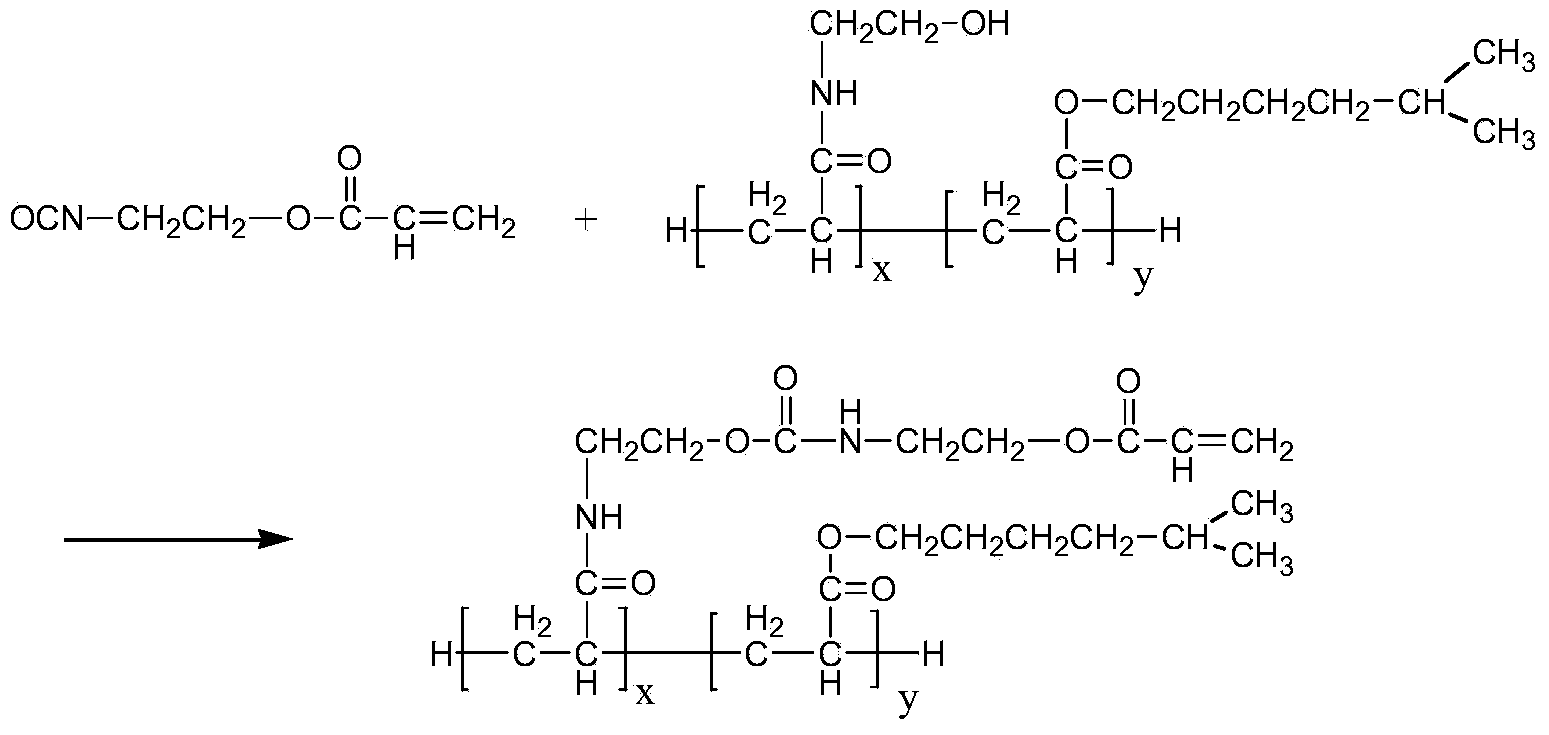Optical pressure-sensitive resin and preparation method thereof
A technology of pressure-sensitive resins and resins, applied in adhesive types, ester copolymer adhesives, etc., can solve the problems of optical pressure-sensitive resins that do not have fast curing and high curing energy, and achieve excellent comprehensive performance and good adhesion , the effect of fast response speed
- Summary
- Abstract
- Description
- Claims
- Application Information
AI Technical Summary
Problems solved by technology
Method used
Image
Examples
Embodiment 1
[0035] Accurately weigh 120g of isooctyl acrylate, 5g of N-hydroxyethylacrylamide (HEAA), 0.01g of polymerization inhibitor p-hydroxyanisole, 1g of n-dodecyl mercaptan (NDM), and 100g of ethyl acetate into In a three-necked flask with a thermometer, raise the temperature to 65 degrees, start to add dropwise a solution of 50 g of ethyl acetate containing 1 g of azobisisobutyronitrile (AIBN), control the temperature at 70-80 degrees, and react for 2.5 hours to obtain a polymer 1. The structural formula is shown in general formula (II), where x=1, y=15,
[0036] Add 6 g of ethyl isocyanate acrylate (AOI) to polymer one, control the temperature at 70-80 degrees, and react for 2.5 hours. Use an infrared spectrometer to analyze the content of NCO groups. When the peak of NCO disappears completely, stop the heating reaction to obtain polyacrylate modified polyurethane acrylate resin. The structural formula is shown in general formula (I), x=1, y=15 , Weight average molecular weight ...
Embodiment 2
[0039]Accurately weigh 100g of isooctyl acrylate, 2g of N-hydroxyethylacrylamide (HEAA), 0.06g of polymerization inhibitor p-hydroxyanisole, 1.2g of n-dodecyl mercaptan (NDM), and 100g of ethyl acetate Into a three-necked flask with a thermometer, raise the temperature to 65 degrees, start dropwise adding 50 g of ethyl acetate solution containing 1.2 g of azobisisobutyronitrile (AIBN), control the temperature at 70-80 degrees, and react for 2.5 hours to obtain Polymer 1, the structural formula is shown in general formula (II), wherein, x=1, y=30,
[0040] Add 2.6 g of ethyl isocyanate acrylate (AOI) to polymer one, control the temperature at 70-80 degrees, and react for 3 hours. Use an infrared spectrometer to analyze the NCO group content. When the NCO peak disappears completely, stop the heating reaction to obtain a polyacrylate modified polyurethane acrylate resin. The structural formula is shown in the general formula (I), where x=1, y= 30. The weight average molecular w...
Embodiment 3
[0043] Accurately weigh 140g of isooctyl acrylate, 11.2g of N-hydroxyethylacrylamide (HEAA), 0.08g of polymerization inhibitor p-hydroxyanisole, 1.3g of n-dodecyl mercaptan (NDM), and 100g of ethyl acetate Add it into a three-necked flask with a thermometer, raise the temperature to 65 degrees, start to dropwise add 50 g of ethyl acetate solution containing 1.9 g of azobisisobutyronitrile (AIBN), control the temperature at 70-80 degrees, react for 2 hours, and get Polymer 1, the structural formula is shown in general formula (II), wherein, x=4, y=30,
[0044] Add 14.1 g of ethyl isocyanate acrylate (AOI) to polymer one, control the temperature at 70-80 degrees, and react for 3 hours. Use an infrared spectrometer to analyze the NCO group content. When the NCO peak disappears completely, stop the heating reaction to obtain a polyacrylate modified polyurethane acrylate resin. The structural formula is shown in the general formula (I), where x=4, y= 30. The weight average molecu...
PUM
 Login to View More
Login to View More Abstract
Description
Claims
Application Information
 Login to View More
Login to View More - R&D
- Intellectual Property
- Life Sciences
- Materials
- Tech Scout
- Unparalleled Data Quality
- Higher Quality Content
- 60% Fewer Hallucinations
Browse by: Latest US Patents, China's latest patents, Technical Efficacy Thesaurus, Application Domain, Technology Topic, Popular Technical Reports.
© 2025 PatSnap. All rights reserved.Legal|Privacy policy|Modern Slavery Act Transparency Statement|Sitemap|About US| Contact US: help@patsnap.com



